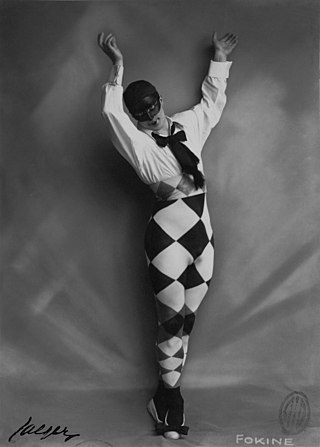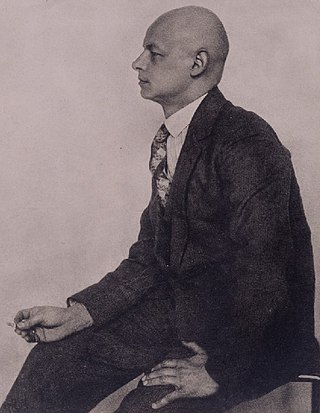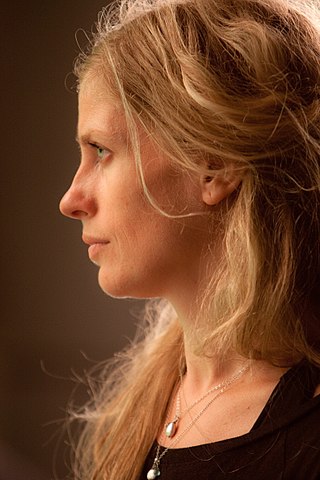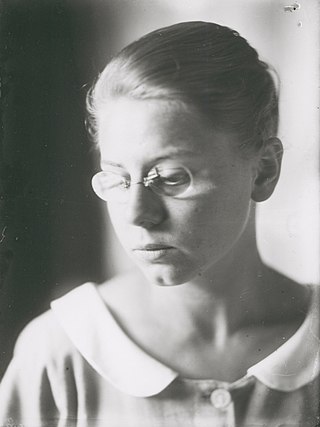
Michael Fokine was a Russian choreographer and dancer.

Kurt Jooss was a famous German ballet dancer and choreographer mixing classical ballet with theatre; he is also widely regarded as the founder of Tanztheater. Jooss is noted for establishing several dance companies, including most notably, the Folkwang Tanztheater, in Essen.

Oskar Schlemmer was a German painter, sculptor, designer and choreographer associated with the Bauhaus school.

Contemporary ballet is a genre of dance that incorporates elements of classical ballet and modern dance. It employs classical ballet technique and in many cases classical pointe technique as well, but allows a greater range of movement of the upper body and is not constrained to the rigorously defined body lines and forms found in traditional, classical ballet. Many of its attributes come from the ideas and innovations of 20th-century modern dance, including floor work and turn-in of the legs. The style also contains many movements emphasizing the body's flexibility.
Georgian dance is the traditional dance of Georgia. It stems from military moves, sports games, and dances celebrated during holidays in the Middle Ages. The dance was popularized by the founders of the Georgian National Ballet, Iliko Sukhishvili, and his wife, Nino Ramishvili.

Crystal Pite is a Canadian choreographer and dancer. She began her professional dance career in 1988 at Ballet BC, and in 1996 she joined Ballett Frankfurt under the tutelage of William Forsythe. After leaving Ballett Frankfurt she became the resident choreographer of Montreal company Les Ballets Jazz de Montreal from 2001 to 2004. She then returned to Vancouver where she focused on choreographing while continuing to dance in her own pieces until 2010. In 2002 she formed her own company called Kidd Pivot, which produced her original works Uncollected Work (2003), Double Story (2004), Lost Action (2006), Dark Matters (2009), The You Show (2010), The Tempest Replica (2011), Betroffenheit (2015), and Revisor (2019) to date. Throughout her career she has been commissioned by many international dance companies to create new pieces, including The Second Person (2007) for Netherlands Dans Theater and Emergence (2009) for the National Ballet of Canada, the latter of which was awarded four Dora Mavor Moore Awards.

Jiří Kylián is a Czech former dancer and contemporary dance choreographer. He is considered one of the greatest contemporary dance choreographers in Czech history.
Set within the Bauhaus design school, the Bauhaus dances were created by Oskar Schlemmer, along with Paul Klee and Wassily Kandinsky, for series of lecture dances between 1927 and 1929. They took as inspiration the architectonic cubical stage space designed by Walter Gropius for the Dessau Bauhaus, which opened in 1926. The dances draw on simple gestures—walking, sitting, jumping—the dancers are to be perceived as figures symbolizing the potential of new technology while remaining primarily an exploration of the human element.
Renato Zanella is an Italian-born ballet dancer, choreographer and director. He studied classical ballet for several years before becoming a choreographer for various professional companies. Due to his success, he has won many awards and honorary titles within the ballet community.

Richard Cragun was an American ballet dancer, teacher and ballet director who performed with the Stuttgart Ballet in Germany from 1965 to 1996.

Will Grohmann was a German art critic and art historian specialized in German Expressionism and abstract art. He was known as the "godfather of modernism".

The Vertiginous Thrill of Exactitude is a ballet choreographed by William Forsythe to the finale of Schubert's Symphony No. 9. The ballet was choreographed for Frankfurt Ballet's programme Six Counter Points, and was presented as a ballet "in the Manner of the late 20th Century." Danced by a cast of five, the ballet features classical and technically demanding choreography. It premiered on 20 January 1996, at Frankfurt. It had since been performed by many other ballet companies.
Katarzyna Kozielska is a Polish ballet choreographer.

Concentric Group is an oil on canvas painting by Oskar Schlemmer, from 1925.
Friedemann Vogel is a German ballet dancer who performs with the Stuttgart Ballet as a Principal dancer and as a frequent guest artist at major ballet companies around the world including La Scala Theatre Ballet in Milan and the Bolshoi Ballet in Moscow. He has been awarded several prestigious dance prizes including the Prix de Lausanne (1997), Prix de Luxembourg (1997), Eurocity Competition in Italy, USA International Ballet Competition (1998) and Erik Bruhn Prize (2002). In September 2015, he was awarded the national title Kammertänzer - the highest honor in Germany that can be bestowed on a dancer. In the following year, 2016, he was awarded the "Prix Maya" for "Outstanding Dancer" alongside Aurélie Dupont and Diana Vishneva. In 2019, he was elected "Dancer of the Year" by the prestigious trade journal TANZ, making him the only male dancer worldwide ever to receive this distinction more than once. In 2020, he is honoured with the "Outstanding Performer" Award by the prestigious German Dance Prize for his longstanding and illustrious international career, and as a unique dance interpreter, with his combination of intense emotional portrayals and excellent technique. In 2021, he was selected to give the official International Dance Day message by the International Theatre Institute - the world's largest performing arts organisation, under the patronage of UNESCO. In 2022, Friedemann was appointed jury member of the prestigious Prix de Lausanne, 25 years after he was a prize winner himself.
Wolfgang Martin Schede was a German writer, dancer, actor, choreographer, artist and photographer. He was credited with being for men's expressionist dance what Mary Wigman was for women's dance. After the experiment of running an expressionist theatre in Cologne, he founded a dance school there in 1923, and worked at the Theater Dessau from 1925. After World War II, he turned to writing, art and photography.

Lou Scheper-Berkenkamp née Hermine Luise Berkenkamp was a German painter, colour designer, the avant-garde author of children's books, fairy-tale illustrator and costume designer.
In Creases is a ballet choreographed by Justin Peck, his first for the New York City Ballet, to Philip Glass' "Four Movements for Two Pianos". The ballet premiered on July 14, 2012, at the Saratoga Performing Arts Center, during the company's annual season there, and had its New York City premiere on May 29, 2013.
Everywhere We Go is a ballet choreographed by Justin Peck and scored by Sufjan Stevens. The ballet is plotless, danced by a cast of 25 and features nine sections. This is the second collaboration between Peck and Stevens, following Year of the Rabbit (2012). Everywhere We Go was created for the New York City Ballet (NYCB), and premiered on May 8, 2014, at the David H. Koch Theater, during NYCB's spring gala. The success of the ballet led to Peck's appointment as resident choreographer of NYCB, as the second person to hold the position.

The Württembergischer Kunstverein Stuttgart was founded in 1827 and is one of the oldest art associations in Germany. The association, which today has around 3,000 members, is based in the Kunstgebäude Stuttgart and is dedicated to communicating contemporary art. The curator and publicist Martin Fritz has been the chairman of the Württembergischer Kunstverein, which belongs to the Arbeitsgemeinschaft Deutscher Kunstvereine (ADKV), since 2018.













